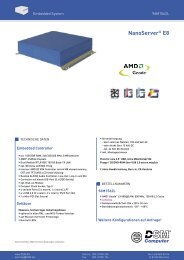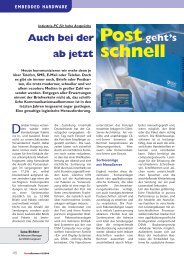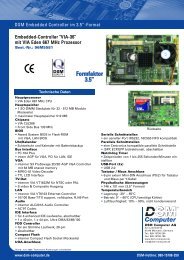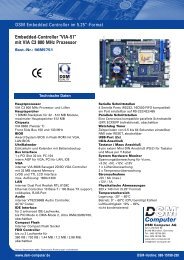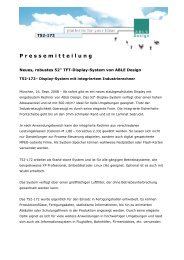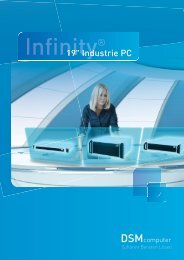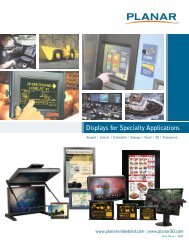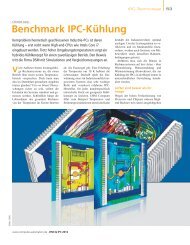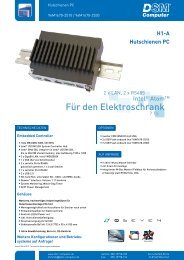Intel Atom processor enables low-power IPC for ... - DSM Computer
Intel Atom processor enables low-power IPC for ... - DSM Computer
Intel Atom processor enables low-power IPC for ... - DSM Computer
You also want an ePaper? Increase the reach of your titles
YUMPU automatically turns print PDFs into web optimized ePapers that Google loves.
INDUSTRIAL COMPUTING<br />
<strong>Intel</strong> <strong>Atom</strong> <strong>processor</strong> <strong>enables</strong><br />
<strong>low</strong>-<strong>power</strong> <strong>IPC</strong> <strong>for</strong> mobile applications<br />
By Christian Lang, <strong>DSM</strong> <strong>Computer</strong><br />
The <strong>low</strong> <strong>power</strong> consumption<br />
of the <strong>Intel</strong> <strong>Atom</strong> <strong>processor</strong><br />
<strong>enables</strong> fanless embedded<br />
PCs in closed housings, suited<br />
to mobile applications, with<br />
battery life extended two to<br />
three times, opening up completely<br />
new possibilities. In<br />
combination with the <strong>Intel</strong><br />
82945GME chipset, a wide<br />
variety of important industrial<br />
interfaces can be offered.<br />
■ In recent years, the focus has increasingly<br />
shifted to the energy efficiency of embedded<br />
computing systems, in addition to computing<br />
<strong>power</strong>. The growing number of industrial applications<br />
in which fanless industrial computers<br />
(<strong>IPC</strong>s) are realized with corresponding I/O<br />
per<strong>for</strong>mance is driving this trend. Low <strong>power</strong><br />
consumption reduces the waste heat of the systems<br />
and <strong>low</strong>ers demands on the cooling concepts.<br />
In this way, completely fanless designs can<br />
be constructed in closed housings. Thanks to<br />
<strong>low</strong> <strong>power</strong> consumption, the <strong>power</strong>-saving<br />
embedded PCs are also suited to mobile applications<br />
and enable an extension of battery life<br />
by two to three times. This opens up a new<br />
range of applications <strong>for</strong> these <strong>IPC</strong>s that only a<br />
matter of months ago seemed to be impossible.<br />
A prerequisite <strong>for</strong> the development of embedded<br />
systems with extreme <strong>power</strong> savings is the<br />
<strong>Atom</strong> <strong>processor</strong> architecture, newly developed<br />
by <strong>Intel</strong>, with unparalleled per<strong>for</strong>mance characteristics.<br />
The <strong>processor</strong> is manufactured in a<br />
45nm process and is cased in small <strong>for</strong>m factor<br />
housing (SFF). The chip, which is just<br />
13x14mm² or 22x22mm², depending on the<br />
version, takes up very little space on the PCB<br />
and features especially <strong>low</strong> <strong>power</strong> dissipation.<br />
The majority of the embedded computing<br />
plat<strong>for</strong>ms presented in recent weeks, based on<br />
the <strong>power</strong>-saving <strong>Intel</strong> <strong>Atom</strong> <strong>processor</strong> archi-<br />
tecture, integrate a CPU from the Z5xx series<br />
and the <strong>Intel</strong> US15W system controller hub.<br />
The two-chip solution is persuasive as a result<br />
of its high energy efficiency, but does not<br />
however offer the wide range of modern interfaces<br />
required by many applications, in particular<br />
in industrial automation technology.<br />
There<strong>for</strong>e, only two PCI Express Lanes are<br />
available, of which one will normally already be<br />
used <strong>for</strong> the Gigabit LAN interface. Additional<br />
interfaces such as further PCI Express or a PCI<br />
bus can only be realized via special bridge chips.<br />
A solution is offered by the combination of the<br />
<strong>power</strong>-saving <strong>Intel</strong> <strong>Atom</strong> N270 <strong>processor</strong>, the<br />
82945GME Northbridge and the ICH7 Southbridge.<br />
The <strong>Intel</strong> 82945GME chipset offers a<br />
wide variety of interfaces important <strong>for</strong> the industry,<br />
such as a PCI Express x16 interface <strong>for</strong><br />
external high-end graphics cards and a dual<br />
DVI/LVDS interface. Additional system expansions<br />
are possible via five PCI Express x1<br />
Lanes. The combination of the <strong>Intel</strong> <strong>Atom</strong> CPU<br />
and <strong>Intel</strong> 945GME chipset makes much more<br />
sense than many of the CPU boards on the<br />
market with the <strong>Intel</strong> 945GC chipset, which exhibits<br />
8 to 9 times the <strong>power</strong> dissipation of the<br />
<strong>processor</strong>. The <strong>Intel</strong> <strong>Atom</strong> N270 <strong>processor</strong> is<br />
clocked with a frequency of 1.6GHz, and with<br />
a thermal design <strong>power</strong> (TDP) of 2.5W has extremely<br />
<strong>low</strong> <strong>power</strong> consumption. The complete<br />
three-chip solution has a theoretical <strong>power</strong> dis-<br />
February 2009 14<br />
Figure 1. The first<br />
embeddedsysteminthe<br />
NanoServer family based<br />
on the energy-saving<br />
<strong>Atom</strong> N270 <strong>processor</strong><br />
from <strong>Intel</strong><br />
sipation of 12.6W. In this way, a range of fanless<br />
applications can be realized that previously only<br />
used the generally expensive <strong>low</strong>-voltage or<br />
ultra-<strong>low</strong>-voltage <strong>processor</strong>s. The N270 CPU<br />
supports <strong>Intel</strong> Enhanced SpeedStep technology.<br />
As a result of the integrated hyper-threading<br />
technology, multiple threads can be executed at<br />
the same time in a single core.<br />
<strong>DSM</strong> <strong>Computer</strong> utilizes the advantages of the<br />
high energy efficiency of the <strong>Intel</strong> <strong>Atom</strong> <strong>processor</strong><br />
technology, and the associated <strong>low</strong>er system<br />
costs, in its new E3-COM NanoServer embedded<br />
PC. The industry-compatible NanoServers<br />
can be used as distributed and independent<br />
client servers, <strong>for</strong> example as control unit,<br />
measured value or communications servers.<br />
The core of the E3-COM NanoServer is a COM<br />
Express baseboard, developed <strong>for</strong> this application,<br />
in MiniITX <strong>for</strong>mat with a COM Express<br />
module based on the N270 CPU and the <strong>Intel</strong><br />
82945GME chipset. In this way, <strong>DSM</strong> is placing<br />
emphasis on the long-term use of the globally<br />
recognized COM Express PICMG standard,<br />
which ensures the long availability of the individual<br />
components on the <strong>Intel</strong> embedded<br />
roadmap. The baseboard and the CPU module<br />
are manufactured in Germany. The scalable<br />
COM Express module utilizes the benefits of<br />
the <strong>Intel</strong> <strong>Atom</strong> <strong>processor</strong> due to its small size of<br />
125mmx95mm (basic <strong>for</strong>mat). In addition, the<br />
interfaces can be led to the outside via the in-
Figure 2. Customer-specific basis board with<br />
energy-saving COM Express module<br />
Figure 3. The E3-COM NanoServer has a<br />
wide range of interfaces.<br />
dividual carrier board in the place where they<br />
are required in the housing design. There<strong>for</strong>e,<br />
the external connections do not have to be cabled<br />
in a complex way in the housing. COM Express<br />
defines all specifications relevant <strong>for</strong> the<br />
industrial application such as PCI Express, PCI,<br />
PEG, USB 2.0, Gigabit Ethernet and SATA via<br />
the two pin-out specification types 1 and 2. The<br />
COM Express connector offers high shock<br />
and vibration stability as well as good EMC behavior.<br />
The E3-COM NanoServer is accommodated in<br />
a high-quality industrial housing with compact<br />
dimensions of 220x220x110mm³. There are<br />
four USB 2.0 ports <strong>for</strong> the flexible connection<br />
of various peripheral devices and high-speed<br />
Gigabit Ethernet. There are four further USB<br />
2.0 ports on the baseboard and these can be led<br />
out of the housing if required. The required<br />
audio functionality can be ensured via the <strong>Intel</strong><br />
high definition or the AC'97 audio interface. A<br />
fast PCI Express 1x Lane as well as a PCI bus<br />
(3.3V / 5V) and a MiniPCI bus complete the<br />
picture. Additional interfaces can be realized on<br />
a customer-specific basis via the I/O shield of<br />
the embedded system.<br />
Thanks to the 950 Graphics Media Accelerator<br />
integrated into the <strong>Intel</strong> 945 chipset, the <strong>IPC</strong> offers<br />
excellent 3D graphics features. The VGA<br />
memory has a capacity of 224 Mbytes (shared).<br />
The internal graphics supports dual independent<br />
displays. If required, the graphics capability<br />
can be expanded via the PCI Express Graphics<br />
(PEG) port. A backlight interface can also be<br />
led to the outside in addition to the VGA, DVI-<br />
INDUSTRIAL COMPUTING<br />
D and LVDS interfaces. With the assistance of<br />
the backlight control, the light intensity <strong>for</strong> the<br />
backlighting of the LCD display module of a flat<br />
screen can be controlled. In order to ensure that<br />
the panel can be operated in energy-saving<br />
mode, the backlight is switched off after a prescribed<br />
interval of time. Displays that are<br />
equipped with a continuously working backlight<br />
control provide constant grayscale display.<br />
This function is on the baseboard and can also<br />
be led to the outside in a customer-specific variant.<br />
For data storage, there is space in the solid PC<br />
housing <strong>for</strong> a rugged 2.5 inch hard disk, which<br />
is suited to the temperature range of -20°C to<br />
+75°C and there<strong>for</strong>e works reliably at <strong>low</strong> external<br />
temperatures. The robust 80 Gbyte hard<br />
disk can run round the clock without interruption,<br />
reaching an MTBF of 750,000 hours.<br />
As an option, connection of a disk-onmodule<br />
or compact flash is possible.<br />
The <strong>IPC</strong> runs on the Windows XP operating<br />
system (embedded). The TrustedCore BIOS<br />
from Phoenix Technologies is implemented on<br />
the COM Express module, which includes security<br />
functions corresponding to the Trusted<br />
Computing Group (TCG). This means that the<br />
copying and modification of customer knowhow<br />
is prevented. For the optimization of the<br />
BIOS, <strong>DSM</strong> has full access to the Phoenix<br />
source code. In addition, the <strong>Computer</strong>-on-<br />
Module integrates the Infineon Trusted Plat<strong>for</strong>m<br />
Module TPM 1.2 SLB 9635.<br />
The target market of the E3-COM embedded<br />
system from the NanoServer family, based on<br />
the <strong>Intel</strong> <strong>Atom</strong> <strong>processor</strong>, is mainly mobile applications,<br />
<strong>for</strong> example in the areas of industrial<br />
automation technology, transport and logistics,<br />
medicinal devices and POS & POI systems. A<br />
new application of the compact computer is<br />
digital signage, which identifies a networked audiovisual<br />
marketing and in<strong>for</strong>mation system,<br />
the content of which can be very rapidly programmed<br />
in a targeted way using software. Digital<br />
signage is used <strong>for</strong> example at rail stations<br />
and airports in order to show departure and arrival<br />
times on a large-scale display. News and<br />
advertising are also targeted to specific groups<br />
in large hotels, clinics and well-visited shopping<br />
malls. Combining these with, <strong>for</strong> example,<br />
event details and local weather in<strong>for</strong>mation assures<br />
that more customer attention is secured<br />
than in the case of pure marketing displays. The<br />
task of the NanoServer in this application is primarily<br />
to control the marketing display with the<br />
representation of the contents. For applications<br />
requiring very high computing <strong>power</strong>, the E3-<br />
COM NanoServer with <strong>Intel</strong> Core 2 L7400 duo<strong>processor</strong><br />
is also supplied. This system can be<br />
operated in the extended operating temperature<br />
range of -10°C to 50°C. ■<br />
15 February 2009<br />
Embedded <strong>Computer</strong>s<br />
Made in Germany.<br />
www.ekf.com<br />
CompactPCI ®<br />
(Express and more …)<br />
with CCM-BOOGIE<br />
• <strong>Intel</strong> ® Core 2 Duo up to 2.26 GHz<br />
• Up to 8 GB DDR3 RAM (4 GB soldered)<br />
• Dual Screen Graphics<br />
• 6 x SATA, 11 x USB 2.0<br />
• Versatile Mass Storage Options<br />
(CF, HDD, SSD)<br />
• Rear I/O and Mezzanine Expansion<br />
via PCI Express<br />
• Customized Expansion Boards<br />
• Ruggedized and long time available<br />
Besuchen Sie uns:<br />
Embedded World<br />
03.–05. Feb. 2009<br />
Halle 12, Stand 313



